The Coconut Adventure
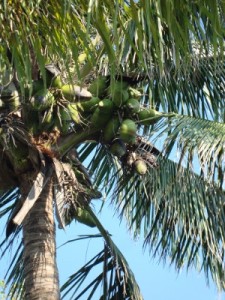
A coconut drupe!
While visiting a friend in Florida we saw a coconut palm with a ripe fruit (called a drupe). We were about to see Russ’ nieces in Disney World and thought they might get a kick out of seeing what a green coconut with the husk looks like, so we asked, and when it dropped we picked it up. We didn’t have any tools though, so while we had an interesting artifact, that’s all it was. We kept thinking about ways to get into it, but without the proper tools we also kept imagining lost fingers. By the the time we got home, the husk was dry and brown.
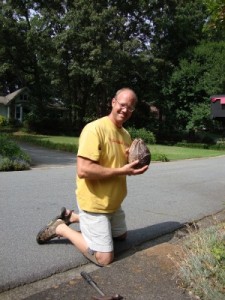
For your viewing pleasure.
Deciding what to do with it was a bit more difficult. I had seen an entire production in Hawaii with an immature green coconut and a machete. We were driving around the Big Island on one of those roads with the warning signs about the potential for unexpected floods and wondering if there was a surprise waiting in the roadway ahead. There was, but it was the Coconut King. He had long dreads bouncing off his shirtless shoulders, a Jamaican accent, a song and a machete. It was quite a production and there was no way to watch it all and then choose not to buy the coconut from him. The milk was sweet and the entertainment was a treat.
If you don’t have the benefit of meeting the Coconut King, there are plenty of instructions for a green coconut, even video on the internet. There are also a lot of instructions for how to open a brown coconut that has had the husk removed, but everything useful for what we had, a brown coconut with the thick brown husk still intact required the strong and skilful use of a machete.
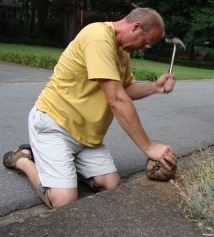
Claw Method
Russ had seen a woman in an apartment complex take a green coconut and beat it on the curb until the husk fell away, so we decided to try that method. It was the safest of all ideas under consideration, but the previously soft green flesh was dried and stringy. You could see the fibers that make planters, door mats and the like very well. Trying to remove it by curb method was slow going. We were reluctant to take the machete route, seeing those tough fibers. The hammer was on hand so Russ turned it around and used the claw side. That was working much better, but still slow going. One of the demonstrations on the internet used a saw, so he cut off a portion of the end with a saw and started again with the claw hammer.
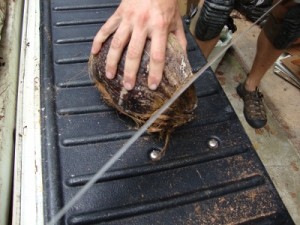
Saw on Tailgate
At one point, he was afraid that he pierced the shell and would loose the milk. The eyes appeared to be exposed, so he jumped ahead to the place where you pierce the eyes with a nail and about a cup of milk came out.
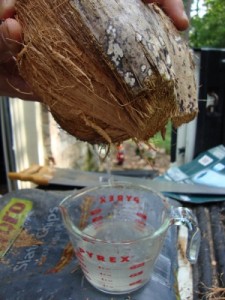
Removing the milk
Then he continued with the claw hammer. Soon much of the nut was exposed and it seemed that breaking it apart and removing it from the husk rather than removing the husk from the nut was the route to take. We also got about a cup of coconut meat from this. The meat was very soft and tender, the softest I’ve ever encountered, with a more delicate flavour than dried coconut.
Russ’ Grandmother reportedly has the best coconut recipe on the planet and fresh coconut is supposed to be one of her tricks, so we will give it a try and see how it turns out.
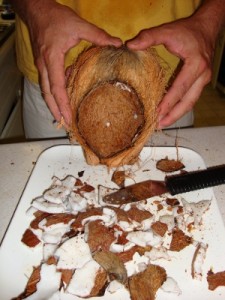
Meat removed from half husk
In the mean time, a friend shared this adult recipe with me. Now this is purely for the purpose of education and by no means a recommendation. Insert all the usual “Don’t try this at home disclaimers” here. Here goes… Apparently torpedo juice (fuel for torpedos) is (or was) very like the Everclear 190 proof beverage that you can get in the liquor store, I’m sure you can see where I’m going with this. A popular coconut treatment when torpedos and coconuts shared the Pacific Theater was to pierce the eyes on a coconut with an ice pick, then fill the coconut with the 190 proof torpedo or human fuel. Then you fill the icepick holes with toothpicks and set it aside. When the toothpicks shoot out of the coconut, your treat is ready. Something tells me that there’s another story here! My imagination runs with all kinds of catastrophe that might befall the person who attempts this with the flying toothpicks and strong alcohol involved. But when “Eat drink and be merry, for tomorrow we may die,” is the prevailing mood, I can see how the risk/benefit trade-off gains a different perspective from the every day life that most of us know.

